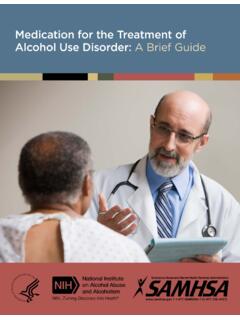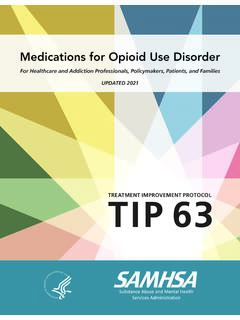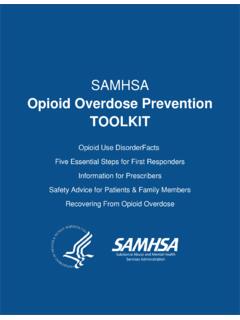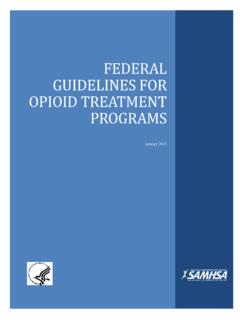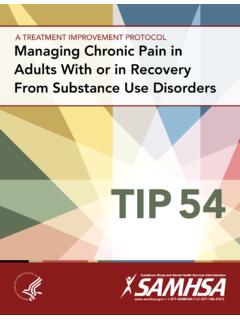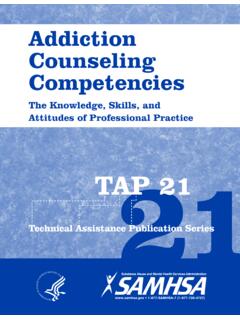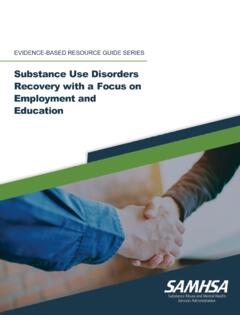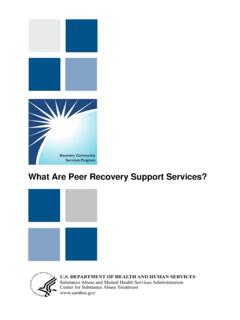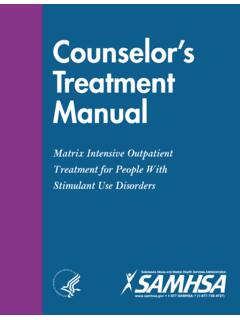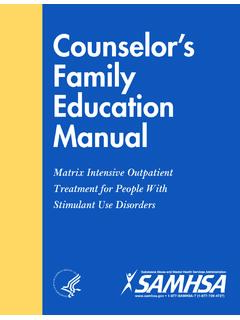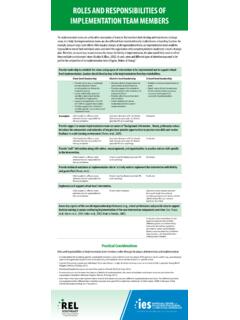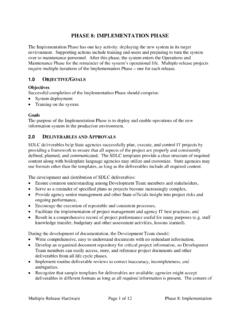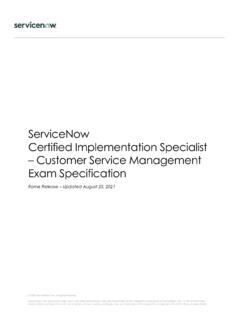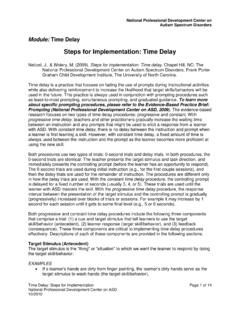Transcription of Guidelines for Successful plan from Jail and
1 Guidelines for Successful Transition of People with Mental or Substance Use Disorders from Jail and Prison: implementation Guideassess plan identify coordinateGuidelines for Successful Transition of People with Mental or Substance Use Disorders from Jail and Prison: implementation GuideAcknowledgmentsThis report was prepared for the Substance Abuse and Mental Health Services Administration (SAMHSA) by Policy Research Associates, Inc. under SAMHSA IDIQ Prime Contract #HHSS283200700036I, Task Order #HHSS28342003T with SAMHSA, Department of Health and Human Services (HHS). David Morrissette, PhD, LCSW, served as the Contracting Officer's views, opinions, and content of this publication are those of the author and do not necessarily reflect the views, opinions, or policies of SAMHSA or HHS. The listing of non-federal resources is not all-inclusive, and inclusion on the listing does not constitute endorsement by SAMHSA or HHS.
2 SAMHSA complies with applicable Federal civil rights laws and does not discriminate on the basis of race, color, national origin, age, disability, or sex. SAMHSA cumple con las leyes federales de derechos civiles aplicables y no discrimina por motivos de raza, color, nacionalidad, edad, discapacidad o Domain NoticeAll material appearing in this report is in the public domain and may be reproduced or copied without permission from SAMHSA. Citation of the source is appreciated. However, this publication may not be reproduced or distributed for a fee without the specific, written authorization of the Office of Communications, SAMHSA Access and Copies of PublicationThis publication may be downloaded at Or, call SAMHSA at 1-877-SAMHSA-7 (1-877-726-4727) (English and Espa ol).Recommended CitationSubstance Abuse and Mental Health Services Administration. Guidelines for Successful Transition of People with Mental or Substance Use Disorders from Jail and Prison: implementation Guide.
3 (SMA)-16-4998. Rockville, MD: Substance Abuse and Mental Health Services Administration, OfficesOffice of Policy, Planning, and Innovation, Substance Abuse and Mental Health Services Administration, 5600 Fishers Lane, Rockville, MD 20857. HHS Publication No. (SMA)-16-4998 Printed in 2017 ContentsIntroduction ..3 Strategic implementation of APIC Guidelines ..8 Assess the individual s clinical and social needs and public safety risks ..8 Plan for the treatment and services required to address the individual s needs (while in custody and upon reentry) ..11 Identify required community and correctional programs responsible for post-release services ..14 Coordinate the transition plan to ensure implementation and avoid gaps in care with community-based services ..17 Conclusion ..24 References ..24 Contributors ..273 IntroductionThe purpose of Guidelines for Successful Transition of People with Mental and Substance Use Disorders from Jail and Prison: implementation Guide is to provide behavioral health, correctional, and community stakeholders with examples of the implementation of Successful strategies for transitioning people with mental or substance use disorders from institutional correctional settings into the community.
4 This guide serves as a direct successor to the 2013 publication Guidelines for the Successful Transition of People with Behavioral Health Disorders from Jail and Prison (Blandford & Osher, 2013), a collaborative product of the SAMHSA s GAINS Center with the Council of State Governments Justice Center, and the 2002 report A Best Practice Approach to Community Re-Entry from Jails for Inmates with Co-Occurring Disorders: The APIC Model (Osher, Steadman, & Barr, 2002). The guide is intended to promote jurisdictional implementation of the APIC Guidelines through the identification and description of various jurisdictional strategies that have been adopted in efforts to facilitate Successful community reentry for justice-involved people with mental and co-occurring substance use and prisons house significantly greater proportions of individuals with mental, substance use, and co-occurring disorders than are found in the general public.
5 While it is estimated that approximately 5 percent of people living in the community have a serious mental illness, comparable figures in state prisons and jails are 16 percent and 17 percent, respectively (Kessler et al., 1996; Ditton, 1999; Metzner, 1997; Steadman, Osher, Robbins, Case, & Samuels, 2009). The prevalence of substance use disorders is notably more disparate, with estimates of percent in the general public (aged 18 or older) but 53 percent in state prisons and 68 percent in jails (Substance Abuse and Mental Health Services Administration [SAMHSA], 2014; Mumola & Karberg, 2004; Karberg & James, 2005). Similarly, the co-occurrence of mental and substance use disorders has been higher among people who are incarcerated in prisons or jails (33 percent to 60 percent) compared with people who are not incarcerated (14 percent to 25 percent) (Wilson, Draine, Hadley, Metraux, & Evans, 2011; Baillargeon, et al.)
6 , 2010; SAMHSA, 2012; SAMHSA, 2009).The high prevalence of mental and substance use disorders in correctional settings produces poorer outcomes for both affected individuals and correctional agencies. Compared to people 4 Guidelines for Successful Transition of People with Mental and Substance Use Disorders from Jail and Prison: implementation Guidewithout mental or substance use disorders, individuals with mental and substance use disorders are less likely to make bail (Council of State Governments Justice Center, 2012), and more likely to have longer jail stays (Council of State Governments Justice Center, 2012), serve time in segregation during incarceration (Metzner & Fellner, 2010), and experience victimization or exploitation (Wolff, Blitz, & Shi, 2007).Within jails and prisons, justice system personnel report that individuals with mental or substance use disorders present with a range of physical, behavioral, and developmental deficits and exhibit greater difficulty coping with institutional rules (Houser, Belenko, & Brennan, 2012).
7 In an effort to address the needs of this population, new or expanded services have been introduced (Hills, Siegfried, & Ickowitz, 2004). The additional expense of these interventions has been justified by pointing to improved individual- and system-level outcomes (Cloud & Davis, 2013). Upon release from jail or prison, many people with mental or substance use disorders continue to lack access to services and, too often, become enmeshed in a cycle of costly justice system involvement (Pew Center on the States, 2011). Indeed, the least developed jail-based service is transition planning (Steadman & Veysey, 1997). The days and weeks following community reentry are a time of heightened vulnerability (Binswanger et al., 2007). Justice system personnel, behavioral health treatment and service practitioners, researchers, and policymakers agree that the maintenance of better individual-level outcomes and a reduction in recidivism necessitate a formalized continuity of services from institution to community settings (Griffin, Heilbrun, Mulvey, DeMatteo, & Schubert, 2015).
8 Local and statewide models for the assessment, design, and cross-system delivery of needed services have been developed in communities such as Allegheny County (PA), Franklin County (MA), Gwinnett County (GA), Hampden County (MA), Hancock County (OH), Montgomery County (MD), and Pima County (AZ) and in statewide initiatives such as those in Hawaii, North Carolina, and New York. This document provides examples of the actual implementation of Successful strategies for transitioning people with mental or substance use disorders from institutional correctional settings into the community. While the highlighted applications necessarily reflect local needs and resources, these implementation strategies are adaptable to a wide variety of communities and justice individual-level outcomes focused on personal recovery require continuity of appropriate services from institution to community settings. Improved system-level outcomes, defined as 5 Upon release from jail or prison, many people with mental or substance use disorders continue to lack access to necessary services and, too often, become enmeshed in a cycle of costly justice system involvement Pew Center on the States (2011)diminished financial expenditures through reduced rates of recidivism, require a concomitant focus on criminogenic risk factors.
9 Realization of enhanced system and individual outcomes depends upon effective coordination of the efforts of behavioral health, correctional, and community stakeholders. Adults with Behavioral Health Needs under Correctional Supervision: A Shared Framework for Reducing Recidivism and Promoting Recovery (Osher, D Amora, Plotkin, Jarrett, & Eggleston, 2012), funded by the National Institute of Corrections (NIC), the Bureau of Justice Assistance (BJA), the Substance Abuse and Mental Health Services Administration (SAMHSA), and supported by the Association of State Correctional Administrators (ASCA), the American Probation and Parole Association (APPA), the National Association of State Mental Health Program Directors (NASMHPD), and the National Association of State Alcohol and Drug Abuse Directors (NASADAD), was developed to provide procedural Guidelines for recidivism reduction, Successful reentry and individual framework (Osher et al.)
10 , 2012) directs behavioral health, justice system, and community stakeholders to work collaboratively across systems to design and implement evidence-based programming to forward the dual goals of individual recovery and risk reduction. The APIC model (Osher, Steadman, & Barr, 2002) provides guidance to assist jurisdictions in this task. The acronym APIC stands for Assess, Plan, Identify, and Coordinate. The 10 associated Guidelines are listed on the following the individual s clinical and social needs and public safety risk Guideline 1: Conduct universal screening as early in the booking/intake process as feasible and throughout the criminal justice continuum to detect substance use disorders, mental disorders, co-occurring substance use and mental disorders, and criminogenic risk. Valid and reliable screening instruments for the target population should be 2: For individuals with positive screens, follow up with comprehensive assessments to guide appropriate program placement and service delivery.
